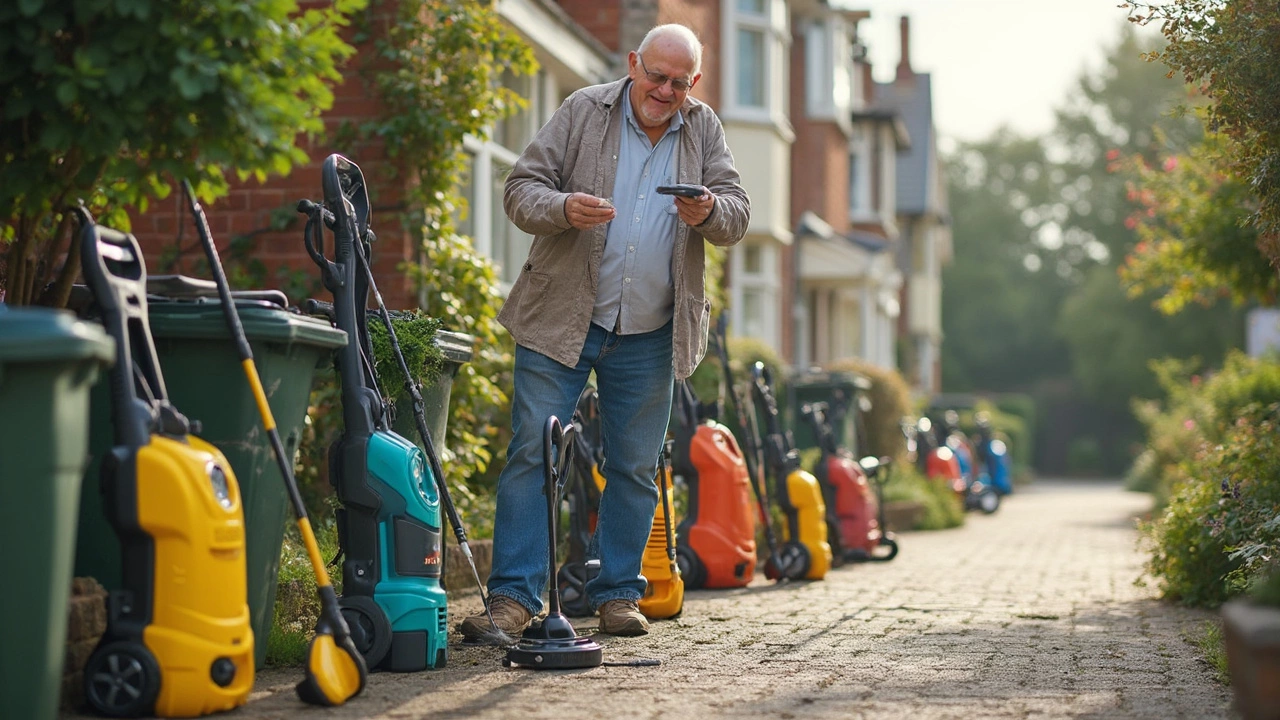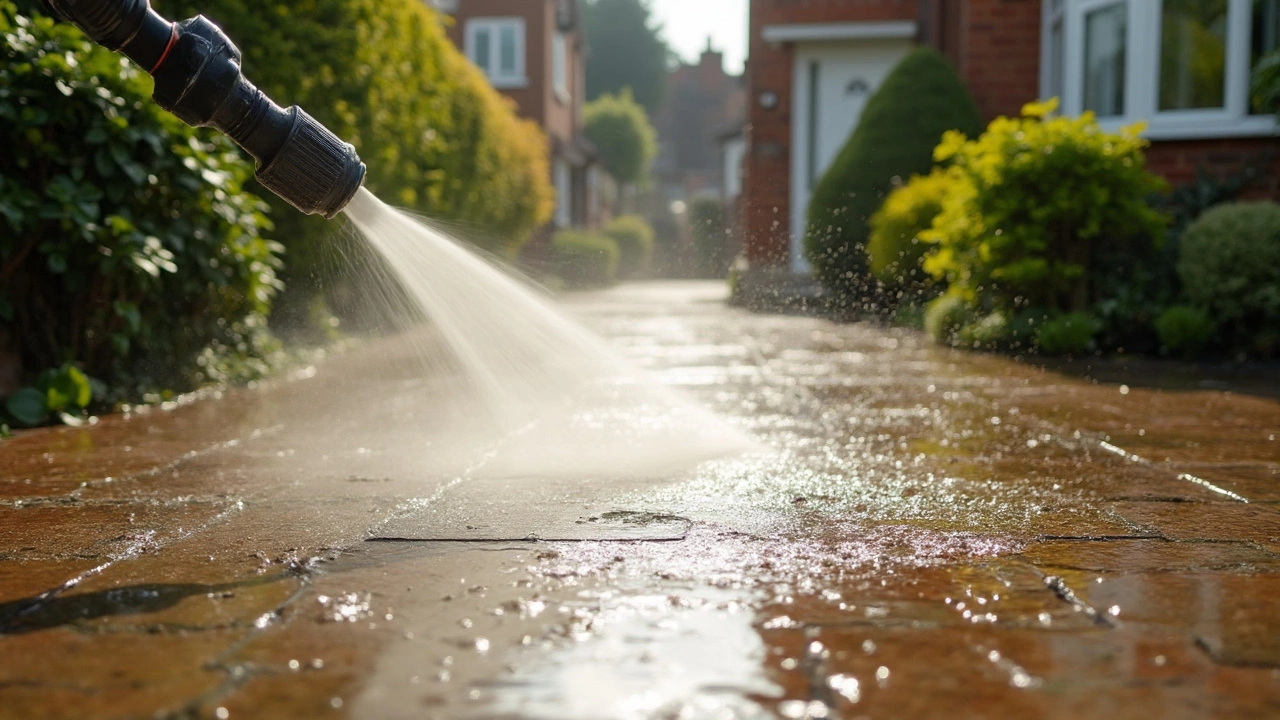If you grab any old pressure washer and blast your driveway, you might be in for a mess—or a repair bill. The PSI, or pounds per square inch, tells you how powerful your pressure washer is. For driveways, you need power, but you don’t need overkill. Most people find that something in the 2,500 to 3,000 PSI range is just right for concrete. Got stubborn oil stains or moss? Stick closer to 3,000 PSI.
Anything less than 2,000 PSI usually leaves dirt and stains behind, while anything much above 3,500 PSI can gouge the concrete or knock loose pavers. Not all driveways are the same, though. Concrete can handle more muscle than asphalt or decorative brick, which can both crack or get damaged at higher pressures. So don’t just look at the biggest number on the box—think about your driveway’s surface and shape first.
- Why PSI Matters for Driveways
- Minimum vs. Maximum PSI: Finding the Sweet Spot
- Matching the Washer to Your Surface
- Tips for a Clean, Damage-Free Driveway
- Mistakes to Avoid When Pressure Washing
Why PSI Matters for Driveways
When it comes to pressure washing your driveway, PSI isn’t just a fancy number—it’s the main thing deciding if your driveway ends up spotless or scarred. PSI stands for pounds per square inch, and it measures how hard the water hits the surface. The right PSI blasts away years of grime, oil, and muddy tire tracks, but the wrong one can crack, pit, or chip your driveway.
Concrete, the most common driveway material, is tough but not invincible. Research from concrete trade groups suggests that 3,000 PSI is about as high as you should go for regular cleaning. If you’re tempted to use a gas-powered machine that can hit 4,000 or even 5,000 PSI, don’t—those are meant for professional jobs, like stripping paint or prepping for heavy repairs. Homeowners using more than 3,500 PSI often end up etching patterns right into the concrete, which is costly to fix.
Other driveway materials, like asphalt or interlocking bricks, are even pickier. Asphalt softens when hot and gets torn up by too much pressure; pavers can have joints blasted out, making a freshly cleaned area look like a puzzle missing pieces. In short, matching PSI to your driveway’s material protects both your investment and your weekend plans.
Here’s a quick look at the recommended PSI range for different driveway surfaces:
| Driveway Material | Recommended PSI |
|---|---|
| Concrete | 2,500–3,000 |
| Asphalt | 1,500–2,000 |
| Pavers/Bricks | 1,500–2,000 |
So before firing up that shiny new washer, take a minute and check what your driveway is made of. It makes all the difference in how clean—and how intact—it’ll be when you’re finished.
Minimum vs. Maximum PSI: Finding the Sweet Spot
Finding the right PSI is where a lot of folks go off track. Anything under 2,000 PSI will get rid of dust and maybe some grass clippings, but it struggles with oil stains or deep-down grime. That's fine for washing your car, but it won’t cut it for most driveways. On the other hand, blowing past 3,500 PSI is overkill for almost any household driveway and can really mess up the surface, especially if the concrete is older or already has cracks.
The most common sweet spot is between 2,500 and 3,000 PSI. Concrete, especially if it’s newer or sealed, handles that range well. Within that window, you have enough muscle to break up stubborn spots but not so much you risk surface damage.
Here’s a quick cheat sheet for driveways:
- Standard concrete: 2,500–3,000 PSI
- Asphalt: 1,500–2,000 PSI (too much and you risk damaging the top layer)
- Decorative pavers or brick: 1,000–2,000 PSI (test a corner first, every material acts a bit different)
Think about your nozzle too. Even with the perfect pressure washer, using a narrow 0° tip at high PSI can slice into surfaces. Stick with a 25° or 40° nozzle for most driveways—this spreads the power and reduces the chance of leaving streaks or gouges.
Check out this simple table to see how pressure, nozzle, and surface all need to work together:
| Surface | Recommended PSI | Best Nozzle Angle |
|---|---|---|
| Concrete | 2,500–3,000 | 25° |
| Asphalt | 1,500–2,000 | 40° |
| Pavers/Brick | 1,000–2,000 | 40° |
Bottom line—pick a washer that fits your actual surface and use the right nozzle. It’s not just about maximum blast; it’s about getting the job done without a hassle or a bill for repairs.

Matching the Washer to Your Surface
Not all surfaces on your driveway are created equal, so it pays to pick a pressure washer that matches your material. Concrete, being tough, can take more force—aim for a washer with 2,500 to 3,000 PSI, as this really moves grime without beating up the driveway. Asphalt is softer than concrete. Crank down the PSI to around 2,000, or you risk stripping off the top layer and making the surface rough or crumbly. Decorative pavers or brick? They're popular for a reason, but they need some extra care. Keep it under 2,000 PSI to avoid popping them loose or blasting away the joint sand.
This isn’t just about PSI, though. The nozzle you use totally changes the power. Stick with a 25-degree or 40-degree tip for surfaces that can’t handle as much force—narrower jets can etch and damage. Here's a handy table so you don’t have to guess:
| Surface | Recommended PSI | Nozzle Tip |
|---|---|---|
| Concrete | 2,500–3,000 | 25° or 15° |
| Asphalt | 1,500–2,000 | 25° or 40° |
| Pavers/Brick | 1,500–2,000 | 25° or 40° |
One last thing: electric pressure washers usually top out at about 2,000 PSI, so they can be a safe bet for most routine cleaning, especially if you’re nervous about doing damage. For deeper grime or old stains on concrete, you might need to rent or borrow a gas-powered power washer that pushes more PSI. Just go easy—do a test spot before letting it loose on the whole driveway.
Tips for a Clean, Damage-Free Driveway
Getting your driveway spotless without causing harm isn’t rocket science, but there are some solid must-dos. First up, start by sweeping away loose dirt and debris. Pressure washers work best when they’re hitting just the stains, not a layer of leaves or gravel.
When it comes to pressure washing, use the right nozzle. For regular cleaning, a 25-degree green tip covers enough area and won’t tear up the surface. Aim for that sweet spot of 2,500 to 3,000 PSI if you’re cleaning concrete. For anything delicate, like stamped concrete or pavers, dial the pressure back to around 1,500-2,000 PSI and use a wider nozzle.
- Always keep the spray wand moving. Holding it in one spot can etch or scar your driveway.
- Use a consistent sweeping motion, keeping the tip about 12 inches from the surface.
- For oil stains, pre-treat with a degreaser and let it sit for 10-15 minutes before blasting away.
- If you spot stubborn spots, repeat the process but avoid cranking the PSI higher than recommended.
- Check the weather. Dry, sunny days are best so the driveway dries fast, which means less chance for mold or mildew to come back.
Here’s something most folks skip—sealing. After you’re done, a concrete sealer can keep your driveway cleaner for longer and make future pressure washing easier. A study from a 2023 home improvement report showed driveways with sealant stayed visibly cleaner and resisted stains almost 60% longer than untreated ones.
| Surface Type | Recommended PSI | Nozzle Angle |
|---|---|---|
| Concrete | 2500-3000 | 25° |
| Asphalt | 1200-2000 | 40° |
| Pavers/Bricks | 1200-2000 | 25°-40° |
Lastly, don’t forget safety. Wear decent shoes (not flip-flops), eye protection, and keep pets or kids out of the blast zone. Pressure washers can slice skin fast, so respect the tool.

Mistakes to Avoid When Pressure Washing
Pressure washing a driveway looks easy until you make a rookie mistake and end up regretting it. The most common blunder? Using the wrong PSI level. Cranking up your machine above 3,500 PSI on concrete can actually pit the surface, and lower PSI on tough stains just wastes your time. It’s not just about muscle—you also need to use the right nozzle. A 0-degree nozzle sounds powerful, but it’s basically like using a knife on your driveway. Stick with a 25 or 40-degree nozzle for broader coverage and to avoid damaging the surface.
Another big mistake is skipping the prep. Not sweeping away rocks, leaves, or debris can mean those little things shoot out like shrapnel and even put cracks or dents in your driveway. And please, never use household bleach or random cleaners—these can stain or damage your driveway, and runoff can harm your lawn or nearby plants.
Here’s a list to keep you out of trouble with your pressure washing project:
- Never hold the wand in one spot for too long—this can leave ugly marks or lines.
- Always test on a small, hidden spot before hitting the whole driveway.
- Don’t aim the spray too close—a good rule is to start around 12 inches away and only get closer if stains don’t budge.
- Wear closed-toe shoes and eye protection. A blast from a high-PSI washer can actually break skin.
- Check for cracks or loose bricks before you start. High pressure can make these worse, turning small issues into big repairs.
How common are these mistakes? The Cleaning Equipment Trade Association found that 1 in 5 homeowner DIY attempts ends up with driven-in stains from improper technique or with fresh damage to their property. It’s more common than you think to leave tiger stripes or etch marks by going too slow or using the wrong nozzle.
"A pressure washer in the wrong hands can do real damage to surfaces and even cause personal injury. Take time to understand your equipment, the right PSI, and proper safety gear." – Alan Gilmore, Senior Instructor at Power Wash University
Keep these tips in mind and you’ll get pro-quality results at home, saving money and protecting your driveway cleaning investment.
